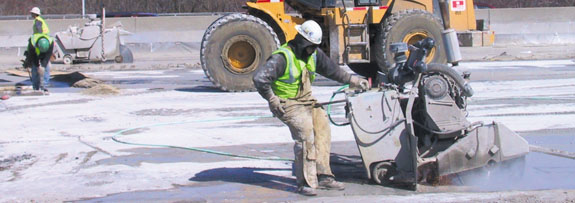Silicosis dust risk nothing to sneeze at
Date Posted: August 20 2004
Death and injury to road workers in construction zones is a familiar and sad story. Usually we think of these tragedies in terms of highway traffic.
Now, another risk to road workers is the subject of a study in the May 2004 issue of the American Journal of Public Health – silicosis.
Silicosis is a disabling, non-reversible and sometimes fatal disease caused by inhaling dust containing extremely fine particles of crystalline silica.
Crystalline silica is a basic component of soil, sand, granite and many other materials. Quartz is the most common form of crystalline silica.
According to the study, highway repair workers are at increased risk for silicosis the longer they work on roads.
Using a jackhammer puts workers at the greatest risk. Other tasks that stir up silica dust include milling asphalt and sawing and cleaning up concrete.
Road materials such as concrete, asphalt and masonry products contain silica sand and other types of crystalline silica.
But road workers are not alone in exposure to this health risk. According to OSHA, silica exposure is a serious threat to nearly two million U. S. workers, including more than 100,000 workers in high risk jobs such as abrasive blasting, foundry work, stonecutting, rock drilling, quarry work and tunneling.
The most severe exposures have occurred during abrasive blasting with sand to remove paint and rust from bridges, tanks, concrete structures and other surfaces.
Respirable silica dust enters the lungs and causes the formation of scar tissue. This reduces the lungs’ ability to take in oxygen. There is no cure for silicosis.
Since silicosis affects lung function, it makes its victims more susceptible to lung infections such as tuberculosis. In addition, smoking causes lung damage and adds to the damage caused by breathing silica dust.
Crystalline silica has been classified as a human lung carcinogen.
Silicosis is classified into three types–chronic/ classic, accelerated and acute–based on length of exposure.
Chronic/classic, the most common form, occurs after 15-20 years of moderate to low exposure to crystalline silica. As the disease takes hold, the worker may experience shortness of breath upon exercising and have clinical signs of poor oxygen/carbon dioxide exchange.
In later stages, the worker may experience fatigue, extreme shortness of breath, chest pain or respiratory failure.
Accelerated silicosis can occur after 5-10 years of high exposure to respirable crystalline silica. Symptoms include severe shortness of breath, weakness and weight loss.
Acute silicosis occurs after a few months or as long as two years following exposure to extremely high concentrations of the silica dust. Symptoms of the acute type include severe, disabling shortness of breath, weakness and weight loss, which often leads to death.
Successful prevention can be as simple as using water to reduce dust levels on the job. But a comprehensive respiratory protection program that requires those workers be provided with – and required to use – proper filtering masks is essential.
(Copyright 2004 by Dr. Phillip L. Polakoff and medical writer Jack Tucker/PAI)

EVEN WITH A WET concrete cutting saw, use of a dust mask is never a bad idea.
